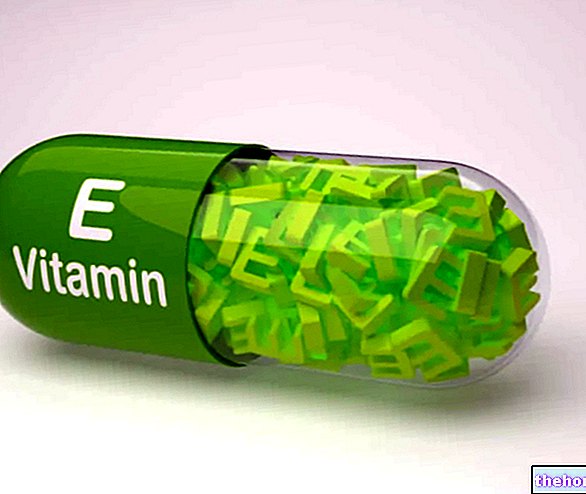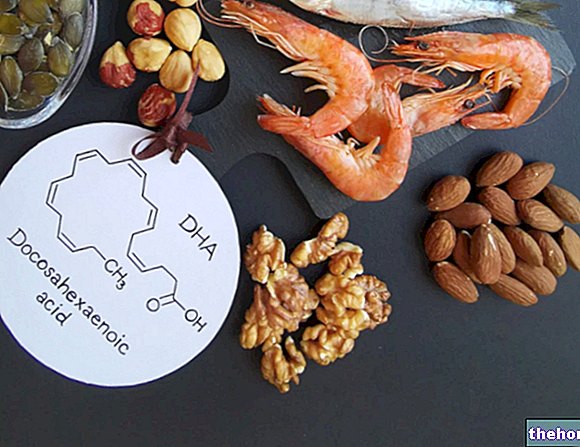Complex carbohydrates: what are they?
Synonyms for "carbohydrates": sugars, carbohydrates, carbon hydrates.
Complex carbohydrates are energetic macronutrients and provide 3.75 calories (kcal) per gram (g); their molecular structure is polymeric, that is, each complex carbohydrate is constituted by the "union of more than 10 simple carbohydrates (up to several thousand). The latter are" monomeric units "made up of MONOSACCHARIDES, which is the most basic form of carbohydrates: glucose, fructose And galactose (The complex energetic carbohydrates for man are based on glucose.) Metaphorically speaking, the monosaccharides constitute the rings, while the chains deriving from their union are represented by the polysaccharides.
All sugars are ternary compounds: hydrogen (H) + oxygen (O) + carbon (C) and their biological function is different between the animal and vegetable kingdoms; in the animal kingdom, carbohydrates are mainly responsible for the production of ATP (Adenosine Tri Phosphate - pure energy) or for the constitution of energy reserves (glycogen for about 1% of body weight), while in the vegetable kingdom (organisms capable of synthesizing them "out of nothing" - autotrophs) these also take on an "important STRUCTURAL function (see cellulose).
Complex carbohydrates for man: what are they?
Complex carbohydrates can be divided according to their molecular variety: those that contain ONLY ONE TYPE of monosaccharides are called homopolysaccharides, while those that contain DIFFERENT ones are defined heteropolysaccharides:
- Homopolysaccharides (thousands of molecules): starch, glycogen, cellulose, inulin and chitin.
- Heteropolysaccharides (thousands of molecules): hemicelluloses, mucopolysaccharides, glycoproteins and pectins.
There is also a classification functional of complex carbohydrates, which is based on their biological function in the VEGETABLE kingdom:
- Nutritional: starch and glycogen.
- Structural: cellulose, hemicellulose, pectin etc.
Complex carbohydrates: nutritional homopolysaccharides
The human being is able to digest complex carbohydrates thanks to a pool enzymatic that acts from the mouth (salivary amylase), up to the intestine (pancreatic amylase and disaccharidase of the intestinal brush border) to split the α-glycosidic bonds 1,4 and 1,6 (position of the carbon linked to the next carbon).
L"nutritional homopolysaccharide starch is the most widespread among plant reserves; it is chemically composed of chains of amylose (20%) e amylopectin (80%), represents the primary energy source of the Mediterranean diet (± 50% of total kcal).
Amylose is a linear polymer composed of 250-300 units, contains α1,4 glycosidic bonds and is soluble in water; Amylopectin is a branched polymer composed of 300-5000 units, contains α-1,4 bonds and (in the points branching) α-1,6 glycosidic. The various types of starch (wheat, rice, barley, corn, etc.) differ in their molecular structure and have a different glycemic index; this means that, although all starches are polymers of glucose, there is a certain structural difference that determines the speed of digestion and absorption.



Complex carbohydrates: importance of structural homopolysaccharides and heteropolysaccharides
Even complex plant structural carbohydrates (homo- or heteropolysaccharides), are molecules of great nutritional value, but lacking in energy function for MAN. They, which also possess β-glycosidic bonds, require specific digestive enzymes and ABSENT in our saliva, pancreas and intestine; on the other hand, many other animals and especially various microorganisms (including those of the intestinal bacterial flora) are able to hydrolyze them, drawing energy from them with the production of water, acids and gas.
OMO-polysaccharides

On the contrary, INULIN is a homo- consisting of FRUCTOSE chains bound by bonds β-2,1 glycosidic; it is very present in artichokes and chicory where it represents a reserve substrate.
CHITIN is a homo- consisting of long chains of a "derivative" of glucose, la acetyl-glucosamine; it is of animal origin and constitutes the carapace of crustaceans and insects.
HETERO-polysaccharides
Among the hetero- the HEMICELLULOSES stand out; are a large group that also contains: xylans, pentosans, arabinosilanes, galactans, etc. They too, like cellulose, constitute dietary fiber and represent a substrate for the intestinal bacterial flora which uses them for energy purposes, releasing gas and acids.
MUCOPOLISACCHARIDES are hetero-present in all animal tissues, where they constitute the PRIMARY element of connective tissue. The main ones are: hyaluronic acid, the chondroitin And the heparin.
GLYCOPROTEINS perform numerous biological functions within the organism; they are molecules conjugated by chains of amino acids and carbohydrates; these molecules include serum albumin, globulins, fibrinogen, collagen, etc.
Among the hetero-of vegetable origin we also remember the PECTINS; long chains of galacturonic acid combined "partially" with methyl alcohol. They combine with cellulose and are amorphous, hydrophobic, NOT fibrous; with the presence of acids and sugars they form GELATINS and are used as food additives in jams etc.
Notes on the digestion of complex carbohydrates
Digestion of complex carbohydrates begins in the mouth; during chewing (in which the jaw, tongue and teeth crush and mix the food) the glands secrete the saliva which mixes and soaks the food bolus. Saliva contains an enzyme, ptyalin or salivary α-amylase, which begins to hydrolyze starch into dextrins and maltose.
In the stomach, complex carbohydrates do NOT undergo other simplification processes, but once introduced into the duodenum and mixed with the juices of the pancreas, they hydrolyze by the action of pancreatic α-amylase, definitively breaking down all the starch chains left behind, amylose and amylopectin, in disaccharides.
The final digestion of the still partially complex chains (disaccharides) takes place SELECTIVELY; in the small intestine the disaccharides are hydrolyzed by the enzymes of the enteric juice; the catalysts responsible are: saccharase for sucrose (with production of glucose and fructose), isomaltase for the α-1,6 bonds of maltose (with production of maltose), maltase for the α-1,6 bonds of maltose (with production of glucose), isomaltase for the α-1,6 bonds (with production of maltose), lactase [if present] for lactose (with production of glucose and galactose) .
Complex carbohydrates: nutritional functions, dietary intake and foods that contain them
Complex carbohydrates are in our body the most important source of energy that is quick to use but at low cost. With the exception of cellulose and other non-digestible molecules (quantitatively secondary), all the carbohydrates we consume with the diet are hydrolyzed, absorbed, transported to the liver and eventually transformed into glucose. The latter is then released into the blood, where it "should" be present in concentrations of 80-100 mg / dl.
In addition to direct glycemic homeostasis, complex carbohydrates contribute to the maintenance of muscle and hepatic glycogen reserves, the latter responsible for glycemic support EVEN in prolonged fasting.
NB. Glycemic homeostasis is essential for maintaining nervous function, but if the intake of carbohydrates is excessive, it can be converted into lipids and contribute to the increase of adipose deposits and / or hepatic steatosis (fat and glycogen).
Complex "non-digestible" carbohydrates are constituents of dietary fiber; this, not being hydrolysed by the enzymes of the human organism, once it reaches the colon undergoes fermentation (and not putrefaction) of the physiological bacterial flora. Dietary fiber is therefore a prebiotic because it promotes the growth of healthier bacterial strains at the expense of harmful ones. It must be introduced for about 30g / day, divided into soluble And insoluble; the soluble one (in water) determines the gelation of the faeces, modulates the absorption of nutrients and consists of: pectins, tires, mucilage And polysaccharides of algae. Insoluble fiber causes an increase in gaseous volume by stimulating peristaltic segmentation contractions and mainly includes: cellulose, hemicellulose And lignin.
The overall requirement of carbohydrates is equal to 55-65% of the total kcal (never less than 50%), and of these about 45-55% must be introduced with complex carbohydrates. Prolonged lack of sugar can lead to serious side effects, such as: chaos, weight loss and muscle depletion, growth retardation; on the other hand, excess contributes: to weight gain, obesity, to favor the onset of type 2 diabetes and to the pathogenesis of other metabolisms.
Dietary sources of complex carbohydrates are mainly:
- Cereals and derivatives (pasta, bread, rice, barley, spelled, corn, rye, etc.)
- Tubers (potatoes)
Dietary sources of fiber are mainly:
- For the soluble product: vegetables and fruit, legumes.
- For the insoluble: cereals and derivatives, legumes.
NB. Complex carbohydrates are an essential energy source especially for sportsmen and athletes who, if they excessively alter the balance of nutrients, worsen the effectiveness and efficiency of the metabolism at the expense of performance. The increase in sugars in an athlete / sportsman who does not introduce enough sugar determines a significantly ergogenic effect.



























